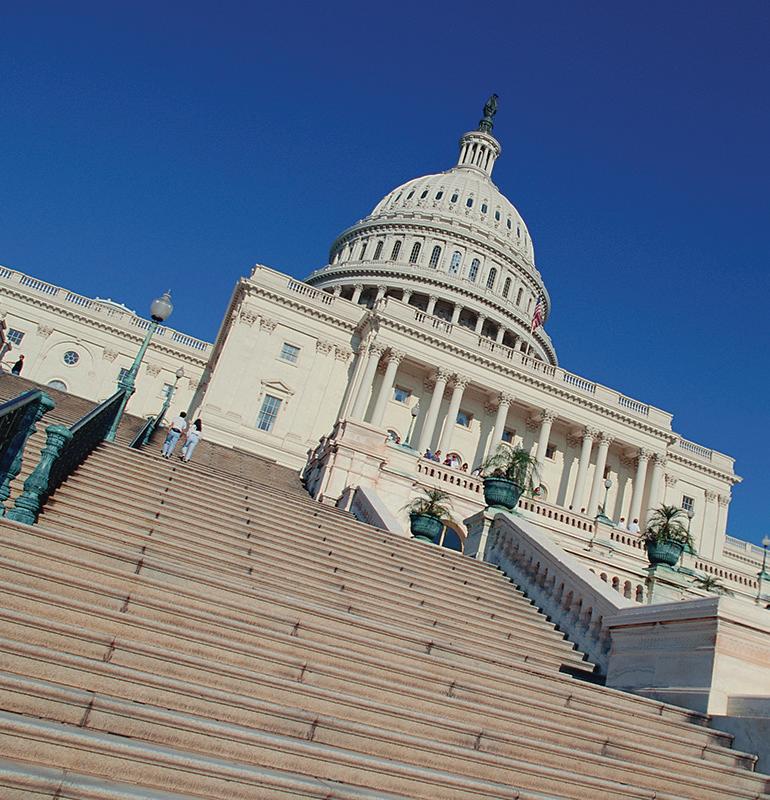
8 minute read
line iTems
VSCPA members and staff meet with legislators during the Virginia General Assembly session in 2012. Visit the Advocacy section at www.vscpa.com for information on how you can attend CPA Assembly Day this January.
Tax reform, export incentives, mobility are priorities in 2014
Advertisement
With the 2014 Virginia General Assembly session upon us, the VSCPA is ramping up its efforts to protect the CPA profession, including two bills introduced by the Society.
As always, the VSCPA supports the Virginia Department of Taxation’s (TAX) tax conformity bill, which conforms Virginia’s tax code with the U.S. Internal Revenue Code. This year’s conformity discussion promises to be a heated one following the joint announcement from the U.S. Internal Revenue Service (IRS) and the U.S. Treasury Department regarding taxation of legally married same-sex couples.
The VSCPA introduced two bills for the 2014 session:
Clarifying the exemption for CPAs in the licensing requirements for private investigators to preserve practice mobility. Currently, the exemption could be interpreted to say that only CPAs holding Virginia licenses are eligible for the exemption. The bill, sponsored by Del. Chris Peace (R-Mechanicsville) would clarify that any CPA authorized to practice in Virginia is allowed to take advantage of the exemption.
Conforming to federal law related to Interest Charge-Domestic International Sales Corporations (IC-DISC). The current lack of conformity creates a disincentive for Virginia companies to create a Virginia-based IC-DISC. Virginia corporations are creating IC-DISCs in competing states, taking business outside the Commonwealth. Sen. Frank Wagner (R-Virginia Beach) and Del. Ron Villanueva (R-Chesapeake and Virginia Beach) are the sponsors.
The VSCPA is also closely monitoring any tax reform proposals introduced. For more information or to alert the VSCPA to any other important issues, contact Government Affairs Director Emily Walker at (804) 612-9428 or ewalker@vscpa.com. n
>> GIVe ’InACtIVe’
A Go, VSCPA tellS VboA
The Virginia Board of Accountancy (VBOA) should establish a formal “inactive” licensure status for CPAs in Virginia, the VSCPA believes.
The VBOA has made it a priority to ensure all Virginia accounting statues and regulations align with the Uniform Accountancy Act (UAA) and related Model Rules. The UAA stipulates that states offer CPAs a CPE requirement exemption for “inactive” status — requiring them to use “inactive” after CPA in their titles, except on their CPA certificates.
While the VBOA currently offers an exemption for licensees who are not providing services to the public or an employer, it does not require the use of “inactive.” This is confusing to licensees, the VSCPA told the VBOA in a Sept. 30, 2013, letter: “We believe the ambiguity of the current regulation creates confusion for licensees and the public as to when CPAs qualify for the CPE exemption.”
The VSCPA gave the VBOA recommendations, such as clearly defining which CPAs are eligible for inactive status.
Find the full letter in the “Advocacy” section of www.vscpa.com, under “VSCPA Positions.” n
DISCLOSURES • JANUARY/FEBRUARY 2014 • HTTP://DISCLOSURES.VSCPA.COM 5
LINE items
A quick brief on Virginia Land Preservation Tax Credits

GET RESEARCH HELP ON DEMAND
The VSCPA has a new program benefit for members who need accounting and legal information fast. Through a partnership with NIQ, VSCPA members can use an online research tool to easily find rules, regulations, statutes, codes, tax case law, pending legislation and more — all from more than 2,500 sources. NIQ’s affiliate company services more than 200,000 attorneys with their legal research needs!
Before partnering with NIQ, the VSCPA reviewed the tool to ensure it is easy to use without training, and at a cost that any practitioner can afford. The tool retails for $79 per month, but VSCPA members receive the specially reduced rate of $46 per month.
Want to try it out first? Call or text (855) 647-8326 for the VSCPA member access code and discount. Visit https://www.niq-taxlaw.com/ memberprivileges/virginia.html for a free trial. n

land donations preserve and encourage permanent open
and undeveloped land while keeping the ownership of that land private. For those concerned that land lost is land lost forever, conservation easements are a way to reverse that trend. Land restricted by a conservation easement is preserved in perpetuity. In Virginia, 6 percent of the land not owned by the federal government is currently subject to permanent conservation easements.
Advocates suggest that conservation easements do permanently what taxation based on land use assessment tries to accomplish every year. That is, they keep open spaces, improving the quality of our air, water and food. To their way of thinking, tax incentives are better spent on land conservation easements than other more temporary methods of land preservation.
To encourage such preservation, the Virginia Land Conservation Incentives Act of 1999 offered strong tax incentives. It allowed a landowner to claim 40% of the value of the easement as tax credits. So if the easement was worth $1 million, the land owner received $400,000 in state tax credits. The amount of the credit used by a taxpayer may not exceed $100,000 for 2012 and subsequent tax years, but any unexpended portion may be carried forward for the next 10 tax years. In addition, any unexpended portion may be transferred to another Virginia taxpayer. A recent tax court opinion suggests that the income from the sale of tax credits held for more than one year prior to sale may receive more favorable long-term capital gains treatment.
Donations of open-space easements that meet federal tax code requirements may entitle the donor to federal income tax deductions. For tax year 2012 (retroactively by the “fiscal cliff” legislation) and tax year 2013, the deduction is limited to 50 percent of adjusted gross income, which if not used up in 2012 or 2013, may be carried forward at 50 percent of adjusted gross income for an additional 15 years or until the donation is fully expended, whichever comes first. In addition, a farmer or rancher who has received in 2012 or will receive in 2013 more than 50 percent of adjusted gross income from the trade or business of farming or ranching is eligible for a tax deduction of 100 percent of adjusted gross income. IRS Form 8283 must be filed to obtain this deduction. Form 8283 requires attachment of a copy of the appraisal, an appraiser’s declaration and VOF’s acknowledgement of the gift. — NIQ Smart Brief n
LINE items
>> EXCELLENT EXCEL
Clean an ugly report in five minutes — Part 2
After reading my last tip in Disclosures on how to remove title, date, etc. from an Excel report that was formatted for printing, a co-worker came to me with another issue that typically slows down an auditor when dealing with data they need to analyze that is not in a continuous block: report formatters remove data that repeats on every line. This is done to make reports easy on the eyes. For example, you may receive from a client an Excel report containing every transaction grouped by their respective account codes. The provider of the report may opt to just use an account code once by placing it on the line with the first transaction associated with it and then will leave the rest of the account code column blank until the report reaches the next account code. While this technique may add white space to the report, there is no way to run your own pivot table against the data without an account code next to each transaction.
If you find yourself in this scenario, here are five steps for adding a column with continuous data:
1. Insert a new column just to the right of the column that has the information you want to use in your analysis and blanks.
In this example, we will assume that column A has account codes that are not repeated on each row and you just inserted a new column B.
2. In the new column (B), next to the top account code in cell B1, write the formula =A1, which brings over that top account code into your new column. In my table, the top account code is in cell A1.
3. In the cell directly under the formula you just wrote (B2 for me), using the “IF” function, write a formula that checks for
“blanks” in the account code column (A).
If the cell in the account code column (B) is blank, the formula should return the value directly above the formula.
On the other hand, if the account code has a value, the formula will return the value directly to the left of the formula in column A. In my example, in cell B2 I wrote =IF(A2="",B1,A2).
4. Copy and paste the formula you just wrote to every cell in column B until you get to the bottom of your data set.
Just remember, you cannot use the auto fill function (e.g., double-click the box in lower right-hand corner of the cell) to copy down your formula because the column just to the left contains blanks.
Excel only copies items down a column until it hits a blank in the cell to the left.
5. Your new column (B) should now contain an account code on every line.
To ensure the account codes do not change in the new column (B), copy the new column (B) and then paste specialvalue only on top of the new column to overwrite your formulas with static amounts. Using values only will ensure the account codes do not inadvertently change as you do your analysis.
You may start analyzing with your continuous block of data. n
GEorGE D. STruDGEoN, CPA, CGFM, is an audit director at the Virginia Auditor of Public Accounts in Richmond. He is a member of the VSCPA Editorial Task Force. Have Excel questions you want him to cover? Email george.strudgeon@gmail.com. No SurPrISE HErE >>

Shutdown hits Virginia hardest
Statistics show the Commonwealth was the state hit hardest during last fall’s government shutdown. WalletHub conducted a survey in October to determine the nationwide effect of the shutdown. Not surprisingly, Virginia and Washington, D.C., have the most federal workers per capita and were thus disproportionately affected.
The states hit hardest, ranked behind Virginia, were Alaska, Alabama, D.C. and Maine. Maryland ranked sixth. In addition to having a large number of federal workers, Virginia, D.C., Maryland, Alaska and New Mexico receive the highest number of federal contract money per capita. That explains all the government contractors in Virginia who were also furloughed during the shutdown.
Check out the full findings from WalletHub at http://tinyurl.com/ k83zhw2. n







